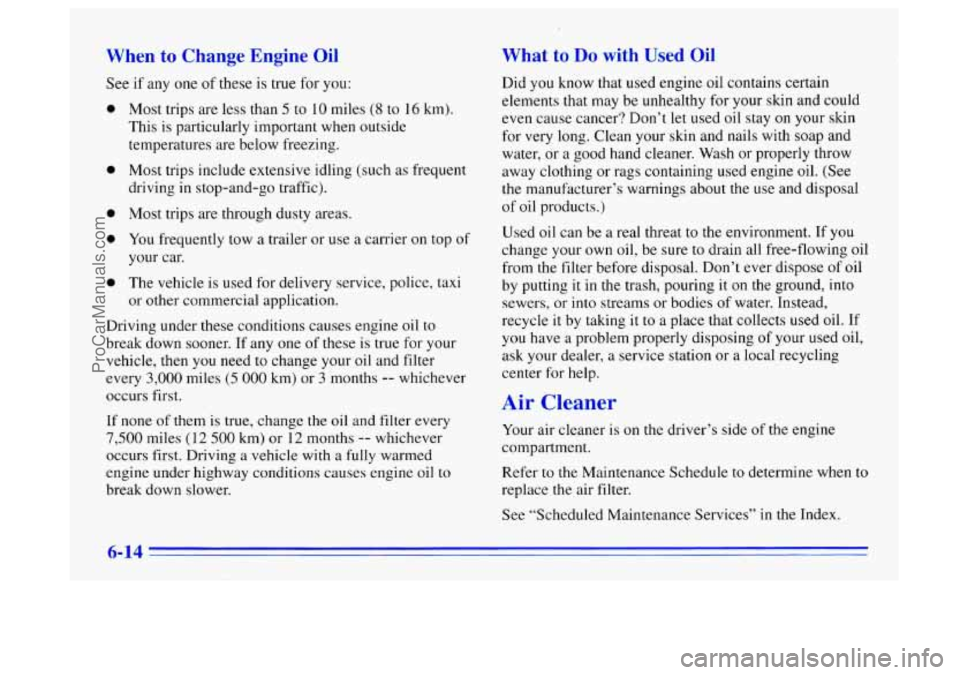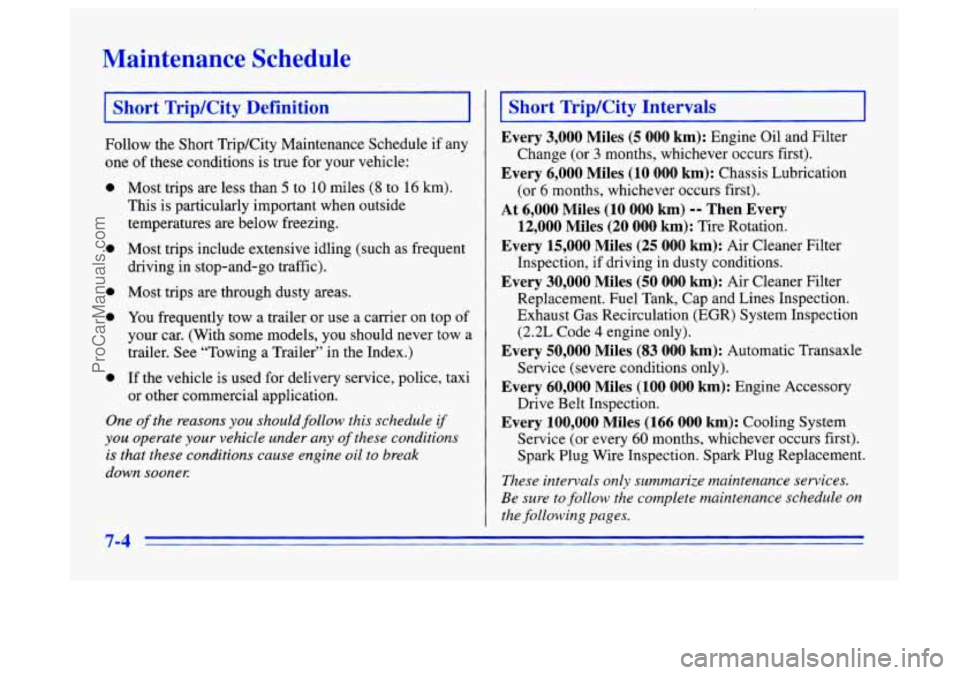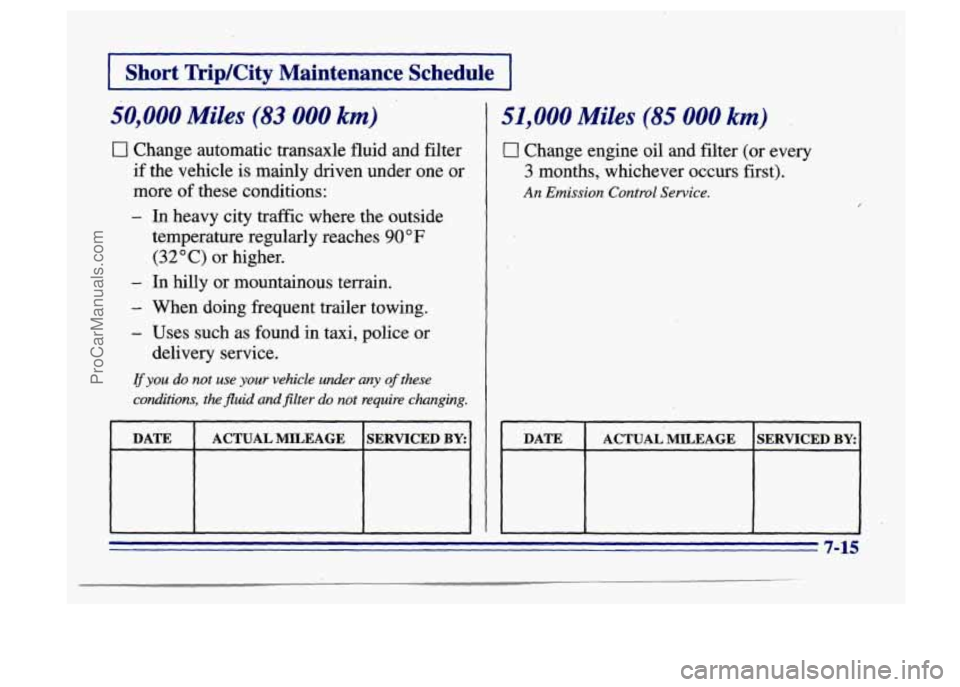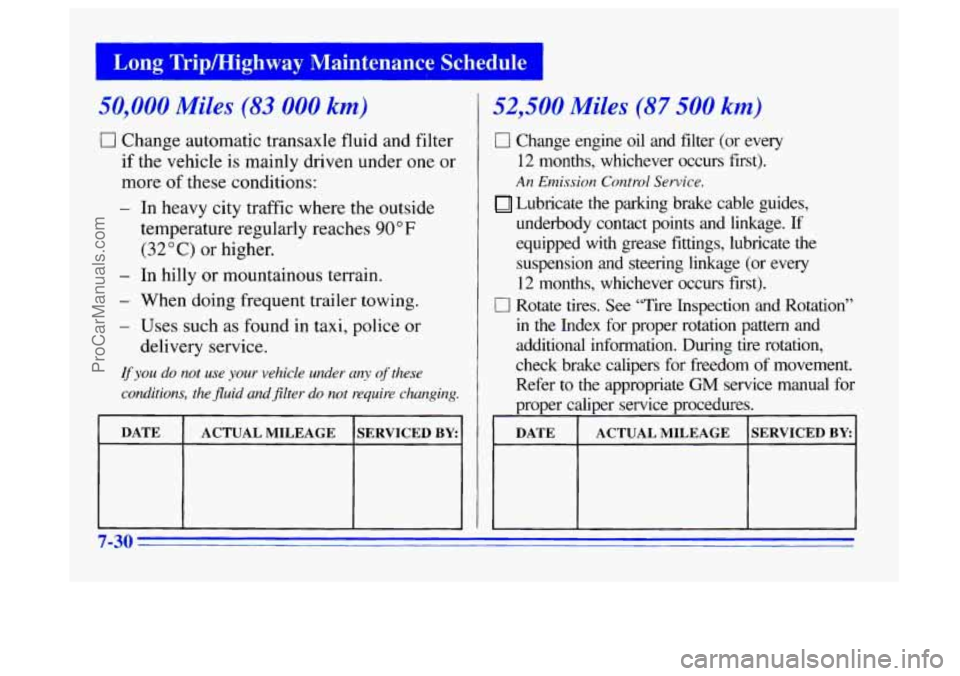1996 BUICK CENTURY oil temperature
[x] Cancel search: oil temperaturePage 73 of 340

10 use the coolant heater:
1. Turn off the engine.
2. Open the hood and unwrap the electrical cord.
3. Plug it into a normal, grounded 110-volt AC outlet.
could cause an electrical shock. Also, the wrong
kind
of extension cord could overheat and cause
a fire. You could be seriously injured. Plug the
cord into
a properly grounded three-prong
110-volt
AC outlet. If the cord won’t reach, use a
heavy-duty three-prong extension cord rated for
at least
15 amps.
4. After you’ve used the coolant heater, be sure to
store the cord as it
was before to keep it away
from moving engine parts. If
you don’t, it could
be damaged.
How long should you keep the coolant heater plugged
in? The answer depends on the outside temperature, the
kind
of oil you have, and some other things. Instead of
trying to list everything here; we ask that you contact
your Buick dealer
in the area where you’ll be parking
your vehicle. The dealer can give
you the best advice for
that particular area.
2-15
ProCarManuals.com
Page 104 of 340

Instrument Panel Cluster
LOW
TRACTION
AIR
BAG
TAILGATE
AJAR
YY
e 20
UNLEADED FUEL ONLY 1 0
P R N[DI32 1
MPH
:i
BRAKE
TEMPERATURE
APPLY BRAKE
TO SHIFT FROM PARK
ANTI -
LOCK
LOW
OIL
Domestic
Your instrument panel is designed to let you know at a glance how your vehicle is running. You'll know how fast
you're going,
how much fuel you're using, and many other things you'll need to drive safely and economically.
2-46
ProCarManuals.com
Page 220 of 340

When to Change Engine Oil
See if any one of these is true for you:
e
e
e
e
a
Most trips are less than 5 to 10 miles (8 to 16 km).
This is particularly important when outside
temperatures are below freezing.
Most trips include extensive idling (such as frequent
driving
in stop-and-go traffic).
Most trips are through dusty areas.
You frequently tow
a trailer or use a carrier on top of
your car.
The vehicle is used for delivery service, police, taxi
or other commercial application.
Driving under these conditions causes engine oil to
break down sooner. If any one of these is true for your
vehicle, then
you need to change your oil and filter
every
3,000 miles (5 000 km) or 3 months -- whichever
occurs first.
If none of them
is true, change the oil and filter every
7,500 miles (12 500 km) or 12 months -- whichever
occurs first. Driving a vehicle with
a fully warmed
engine under highway conditions causes engine oil to
break down slower.
What to Do with Used Oil
Did you know that used engine oil contains certain
elements that may be unhealthy for your skin and could
even cause cancer? Don’t let used oil stay
on your skin
for very long. Clean your skin and nails with soap and
water, or
a good hand cleaner. Wash or properly throw
away clothing or rags containing used engine
oil. (See
the manufacturer’s warnings about the use and disposal
of oil products.)
Used oil can be a real threat to the environment. If you
change your own oil, be sure to drain all free-flowing oil
from the filter before disposal. Don’t ever dispose of oil
by putting it
in the trash, pouring it on the ground, into
sewers, or into streams or bodies
of water. Instead,
recycle it by taking
it to a place that collects used oil. If
you have a problem properly disposing
of your used oil,
ask your dealer, a service station or a local recycling
center for help.
Air Cleaner
Your air cleaner is on the driver’s side of the engine
compartment.
Refer to the Maintenance Schedule to determine when
to
replace the air filter.
See “Scheduled Maintenance Services” in the Index.
6-14
ProCarManuals.com
Page 223 of 340

Automatic Transaxle Fluid
A good time to check your automatic transaxle fluid
level
is when the engine oil is changed.
Change both the fluid and filter every
50,000 miles
(83 000 km) if the vehicle is mainly driven under one or
more of these conditions:
In heavy city traffic where the outside temperature
regularly reaches
90” F (32°C) or higher.
In hilly or mountainous terrain.
When doing frequent trailer towing.
Uses such as found in taxi, police or delivery service.
If you do
not use your vehicle under any of these
conditions, the fluid and filter do not require changing.
See “Scheduled Maintenance Services” in the Index.
How to Check
Because this operation can be a little difficult, you may
choose to have this done at your Buick dealership’s
Service Department.
If you do
it yourself, be sure to follow all the instructions
here, or you could get a false reading
on the dipstick.
~~
NOTICE:
Too much or too little fluid can damage your
transaxle.
Too much can mean that some of the
fluid could come out and fall on hot engine parts
or exhaust system parts, starting
a fire. Be sure to
get an accurate reading if you check your
transaxle fluid.
6-17
ProCarManuals.com
Page 274 of 340

Maintenance Scl aule
1 Short Trip/City Definition 1
Follow the Short Trip/City Maintenance Schedule if any
one
of these conditions is true for your vehicle:
a
a
a
a
0
Most trips are less than 5 to 10 miles (8 to 16 km).
This is particularly important when outside
temperatures
are below freezing.
Most trips include extensive idling (such as frequent
driving
in stop-and-go traffic).
Most trips are through dusty
areas.
You frequently tow a trailer or use a carrier on top of
your car. (With some models, you should never tow a
trailer. See “Towing a Trailer” in the Index.)
If the vehicle is used for delivery service, police, taxi
or other commercial application.
One
of the reasons you should follow this schedule if
you operate your vehicle under any of these conditions
is that these conditions cause engine oil to break
down sooneE
Short Trip/City Intervals -
Every 3,000 Miles (5 000 km): Engine Oil and Filter
Change (or
3 months, whichever occurs first).
Every 6,000 Miles (10 000 km): Chassis Lubrication
(or
6 months, whichever occurs first).
At 6,000 Miles (10 000 km) -- Then Every
12,000 Miles (20 000 km): Tire Rotation.
Every 15,000 Miles (25 000 km): Air Cleaner Filter
Inspection, if driving in dusty conditions.
Every 30,000 Miles (50 000 km): Air Cleaner Filter
Replacement. Fuel Tank, Cap and Lines Inspection.
Exhaust Gas Recirculation (EGR) System Inspection
(2.2L Code 4 engine only).
Every 50,000 Miles (83 000 km): Automatic Transaxle
Service (severe conditions only).
Every 60,000 Miles (100 000 km): Engine Accessory
Drive Belt Inspection.
Every 100,000 Miles (166 000 km): Cooling System
Service
(or every 60 months, whichever occurs first).
Spark Plug Wire Inspection. Spark Plug Replacement.
These intervals only summarize maintenance services.
Be sure to follow the complete maintenance schedule on
the following pages.
7-4
ProCarManuals.com
Page 285 of 340

I Short Trip/City Maintenance Schedule I I I
50,000 Miles (83 000 km) 1 51,000 Miles (85 000 km)
0 Change automatic transaxle fluid and filter
if the
vehicle is mainly driven under one or
more of these conditions:
- In heavy city traffic where the outside
temperature regularly reaches
90 OF
(32 O C) or higher.
- In hilly or mountainous terrain.
- When doing frequent trailer towing.
- Uses such as found in taxi, police or
delivery service.
Ifyou do not use your vehicle under any of these
conditions,
the fluid and filter do not require changing.
I DATE ACTUAL MILEAGE SERVICED BY:
0 Change engine oil and filter (or every
3 months, whichever occurs first).
An Emission Control Service.
-
DATE
SERVICED BY: ACTUAL MILEAGE I- --<-. _*--- - -
7-15
ProCarManuals.com
Page 300 of 340

50,000 Miles (83 000 km)
0 Change automatic transaxle fluid and filter
if the vehicle is mainly driven under
one or
more of these conditions:
- In heavy city traffic where the outside
temperature regularly reaches
90°F
(32°C) or higher.
- In hilly or mountainous terrain.
- When doing frequent trailer towing.
- Uses such as found in taxi, police or
delivery service.
Ifyou do not use your vehicle under any of these
conditions, the fluid and filter do not require changing.
DATE ACTUAL MILEAGE SERVICED BY:
52,500 Miles (87 500 km)
17 Change engine oil and filter (or every
12 months, whichever occurs first).
An Emission Control Service.
Lubricate the parking brake cable guides,
underbody contact points and linkage.
If
equipped with grease fittings, lubricate the suspension and steering linkage (or every
12 months, whichever occurs first).
0 Rotate tires. See “Tire Inspection and Rotation”
in the Index for proper rotation pattern and
additional information. During tire rotation,
check brake calipers for fieedom of movement. Refer to the appropriate
GM service manual for
proper caliper service procedures.
DATE ACTUAL MILEAGE SERVICED BY:
7-30
ProCarManuals.com
Page 331 of 340

Cruise Control .................................. 2-30
Cupholders
.................................... 2-39
Customer Assistance Information
................... 8- 1
Customer Satisfaction Procedure .................... 8- 1
Damage. Finish ............................... 6-52
Damage. Sheet Metal
............................ 6-52
Daytime Running Lamps
......................... 2-34
Dead Battery
................................... 5-2
Defects. Reporting Safety
......................... 8-7
Defensive Driving
............................... 4- 1
Defogger. Rear Window
.......................... 3-3
Defogging
..................................... 3-2
Defrosting
..................................... 3-2
Dimensions. Vehicle
............................ 6-63
Door
Drive Position. Automatic Transaxle
................ 2- 18
Driver Position
................................. 1 - 13
Driving
City
....................................... 4-19
Defensive
.................................... 4-1
Drunken
..................................... 4-2
Freeway
.................................... 4-20
In a Blizzard ................................. 4-26
In Foreign Countries
........................... 6-4
IntheRain
.................................. 4-16
Night
...................................... 4-14
OnCurves
................................... 4-9
On Grades While Towing a Trailer ............... 4-35
On Hill and Mountain Roads
.................... 4-22
Customer Assistance for
Text Telephone Users
......... 8-3
Locks
....................................... 2-3 OnSnowandIce
............................. 4-25
Wet Roads
.................................. 4-16
Winter ...................................... 4-24
With a Trailer
................................ 4-34
DrunkenDriving
................................ 4-2
Electrical Equipment. Adding
................ 3-9. 6-56
Electrical System
............................... 6-56
Engine 6-8. 6-9
Engine
Coolant
..................................... 6-22
Coolant Heater
............................... 2-14
Coolant Level Check
.......................... 7-37
Coolant Temperature Gage
..................... 2-54
Exhaust
..................................... 2-24
Identification
................................ 6-55
OilLevelCheck
.............................. 7-37
Overheating
................................. 5-13
Running While Parked ......................... 2-24
Specifications
................................ 6-63
Starting Your
........................... 2- 12. 2-13
Engineoil
.................................... 6-10
Adding
..................................... 6-12
Additives
................................... 6-13
Checking
................................... 6-10
Used
....................................... 6-14
Whentochange
.............................. 6-14
Engine
Oil Pressure Light ........................ 2-57
Ethanol
........................................ 6-3
Through Deep Standing
Water
................... 4-18
Coolant Temperature Warning Light
.............. 2-53
Exhaust. Engine
................................ 2-24
9-3
ProCarManuals.com